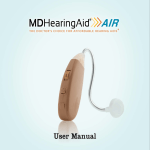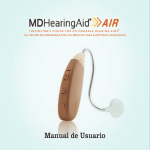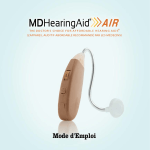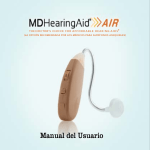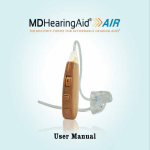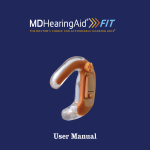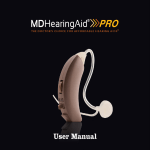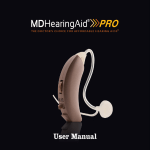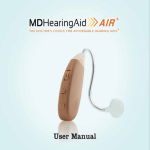Download MDHearingAid AIR User manual
Transcript
Borro moluptat rae moditaspis Borro moluptat rae moditaspis Printed in U.S.A. 09.13 A34 A1 Congratulations! As the owner of the MDHearingAid® AIR Hearing Aid, you may once again enjoy the sounds of your environment and conversations with your family and friends at a price you can afford. In order to get the most out of your MDHearingAid® AIR, please read this User Manual in its entirety. Your satisfaction with hearing aids depends on both the type and degree of your hearing loss as well as your expectations. No hearing aid can restore normal hearing, and not everyone will benefit equally. Please read this manual in its entirety before using your MDHearingAid®AIR. Thank you! Table of Contents The MDHearingAid® Story . . . . 2 Battery Information . . . . . . . . 22 Hearing Aid Diagram . . . . . . . . 4 Maintenance & Care . . . . . . . 24 Quick Start Guide . . . . . . . . . . 5 In Case of Malfunction . . . . . . 25 Package Contents . . . . . . . . . . 6 Troubleshooting . . . . . . . . . . . 26 Fitting & Assembly 1. Select Ear Dome . . . . . . . 8 2. Attach AIR Tubing . . . . . . 10 3. Insert Battery . . . . . . . . . 11 4. Place Behind Ear . . . . . . 12 5. Turn Hearing Aid On . . . . 13 Replacement Parts . . . . . . . . 30 Selecting a Program . . . . . . . 14 Phone/Telecoil Program . . . . 16 Getting the Most from . . . . . . 18 Your Hearing Aid Warranty & Repair . . . . . . . . . 31 Return Policy . . . . . . . . . . . . . 32 Warnings . . . . . . . . . . . . . . . . 34 Important Notice for . . . . . . . . 36 Prospective Users Notice of Cancellation . . . . . . 38 Technical Specifications . . . . 39 The MDHearingAid® AIR Story The MDHearingAid® AIR was invented by a board-certified Ear, Nose and Throat physician in Chicago, IL, Dr. Cherukuri. He encountered patients in his daily practice who would benefit from hearing aids, but many simply couldn’t afford the thousands of dollars needed to pay for them. As a physician, he knew the effects of untreated hearing loss: depression, social isolation, anxiety, and other symptoms consistent with Alzheimer's disease. Dr. Cherukuri set out to find a reasonable solution that could help with the most common types of hearing loss at a reasonable price. He was looking for a “one-size-fits-most” hearing aid, similar to reading glasses, that can easily be purchased at the drug store. 2 He evaluated numerous hearing aids and sound amplifiers, including those seen on television. He found almost all of these devices only amplified low frequencies (below 1000 Hz); however, the majority of hearing loss is in the higher frequencies (1000-4000 Hz), those most related to the human voice. Dr. Cherukuri worked with world-class Doctors of Audiology and Audiologists to create the MDHearingAid® AIR. Built to exacting specifications, the MDHearingAid® AIR includes advanced technologies found on hearing aids costing thousands of dollars more such as: • Advanced feedback cancellation to reduce and eliminate "whistling" • Advanced compression technology to magnify soft sounds and dampen loud sounds • Advanced noise reduction that reduces noises embedded in speech and maximizes sound quality • Digital amplification to accurately reproduce speech and sounds to enhance listening comfort • A Telecoil setting for easy use with compatible telephones or looped environments found in many churches, theatres and public buildings The MDHearingAid® AIR has been rigorously tested by leaders in the hearing loss field (ENT Physicians and Audiologists) who have unanimously agreed that the sound quality and output is incredibly accurate. 3 MDHearingAid®AIR Diagram AIR Tubing Base Volume Dial (on/off switch) Program Button Battery Compartment Quick Start Guide AIR Tubing Body Steps Five Easy Steps for Fitting and Assembling Your MDHearingAid® AIR Step 1: S elect the Correct Ear Dome Types: Open-Fit or Closed Ear Dome Sizes: 6 mm – 15 mm Step 2: A ttach AIR Tubing Base to Hearing Aid Body Step 3: Insert Battery Step 4: Place Hearing Aid Behind Ear Step 5: Turn the MDHearingAid® AIR On Stabilizer Bar Ear Dome 4 5 MDHearingAid® AIR Package Contents Closed Domes Left Ear Right Ear Wire Magnet 6 Open-Fit Domes Brush Right and Left ear AIR Tubing Cleaning Tool • For Right ear, use the tubing labeled '2B' in Red Use Brush for removing wax around Ear Dome. Use the Magnet for replacement of battery. Use Wire to clean tubing (after removing Hearing Aid Body). • For the Left ear use the tubing labeled '2B' in Blue. Ear Dome Selection Optional Traditional Earhook System • Open-Fit Domes (vented) allow natural sound to enter the ear. Best for individuals who have high frequency loss and do not require high volume. This is ONLY for people needing maximum volume or a customized tubing length. (See separate package located under tray.) • Closed Domes are best for individuals who have low to high frequency loss or require higher volumes. 7 Step 1 Fitting and Assembly Step 1: Select the Correct Ear Dome Attach Ear Dome to AIR Tubing Use Right AIR Tubing (Red lettering) for fitting Right ear. Use Left Tubing (Blue lettering) for fitting Left ear. a) Hold the AIR Tubing at the junction of the Stabilizer Bar with one hand and hold the 'mushroom' top of the Ear Dome with the other hand. 8 a) Insert Ear Dome in Ear Canal a) Pull the outer ear upward and backward. With your other hand, hold the AIR Tubing (with Ear Dome attached) at the junction of the Stabilizer Bar. b) Push the Ear Dome over the ridges on the end of the AIR Tubing. b) Insert Ear Dome into the ear canal. It should fit in ear canal without protruding into the outer bowl of the ear. When the Ear Dome is too small, there is space between the Ear Dome and the ear canal, and you may hear whistling (feedback) when the Hearing Aid is on. c) Pull in the reverse direction to make sure the Ear Dome is attached securely. c) Nod head towards the ground to make sure that the Ear Dome does not slip out easily. Please note: while testing different Ear Dome sizes its best not to attach AIR Tubing to Hearing Aid Body. b) c) Repeat the 3 steps above with different sized Ear Domes to find the best one for you. a) b) c) 9 Step 2 Step 3: Insert Battery a) Hold the top of the AIR Tubing Base (the triangular end), and place it on the Hearing Aid Body's threaded end. To power up your Hearing Aid, please insert one of the included size 13 batteries. a) c) Make sure the slots in the Base are flush with the wide sides of Hearing Aid Body. a) a) Push the Nail Grip downward to open the Battery Compartment. b) Twist the Hearing Aid Body clockwise, while gently pushing AIR Tubing Base onto threaded end of Hearing Aid Body. b) b) Remove the orange adhesive tab from the battery. With the red "+" side of Battery Compartment facing up, use the Cleaning Tool Magnet to insert the Battery. b) Or, use orange adhesive tab to place battery in the Battery Compartment. Then remove adhesive tab and discard. c) 10 Step 3 Step 2: Attach AIR Tubing Base to Hearing Aid Body c) Close the Battery Compartment. If the Battery Compartment does not close easily, the battery is inserted upside down. c) Positive Side up 11 Step 4 Step 4: Place Hearing Aid Behind Ear a) Insert Ear Dome into the ear canal until the Ear Dome fits securely. For more details see pictures on page 9. b) Place the Hearing Aid Body behind the ear so the curve of the AIR Tubing rests comfortably on the top of ear in front of any eye wear. c) Tuck the Stabilizer Bar in the outer bowl of the ear. Please note: The Stabilization Bar is often hidden when tucked in the outer bowl of the ear and is not shown on the cover of box. 12 a) Step 5 Step 5: Turn the MDHearingAid® AIR On The MDHearingAid ® AIR uses a Volume Dial with a built in on/off switch (like a radio). • To turn the Hearing Aid on, turn the Volume Dial upward, past the click. Volume Dial • To turn the Hearing Aid off, turn the Volume Dial downward until you feel a click. b) c) IMPORTANT: When the Hearing Aid is turned on, it will take a few seconds to begin amplifying sound. Please raise the volume SLOWLY to avoid sudden blast of sound. WARNING: Whistling may be heard if the Hearing Aid is turned on but not positioned securely in your ear. This is normal. Once the Ear Dome is properly inserted in your ear, the whistling will stop. on off 13 Selecting a Sound Processing Program The MDHearingAid ® AIR has four Sound Processing Programs to address the most common hearing loss environments. Try the different programs in each environment to find which Program works best for you. Program Best For Description 1. Normal Quiet Mode Home, watching TV, time with family. Increases sound in 1 Tone ALL frequencies. • Once turned on, the MDHearingAid ® AIR starts on Program 1. This is the default setting; every time the Hearing Aid is turned off and then on again, it will re-set to Program 1. 2. Low Social Mode Social settings: group meetings, church, time with friends. Low frequencies (most background noises) up to 1000 Hz are not amplified. 2 Tones 3. High Noisy Mode Intense noise situations: parties, restaurants, traffic or large crowds. Ideal for people with high frequency hearing loss. Frequencies up to 1500 Hz are not significantly amplified. 3 Tones 4. Telecoil Use with compatible telephones and looped environments (pg. 16). Telecoil enabled. Microphone is off. 4 Tones • To access the other Programs, press the Program Button and you will hear a number of audible tones corresponding to the Program number: 14 1 Tone = Program 1 2 Tones = Program 2 3 Tones = Program 3 4 Tones = Telecoil Please note: The tones may be faint depending on the volume setting and background noise. Program Button Indicator 15 Using the Telephone/Telecoil Program The MDHearingAid ® AIR is equipped with a Telecoil Program. Telecoils, also known as an Audio Induction Loops, enable the direct magnetic coupling of your Hearing Aid to compatible telephones and other audio sources. Telecoils provide clear sound that is free of background noise and feedback. Telecoils enable you to comfortably use the telephone without removing your Hearing Aid. To activate the Telecoil mode (Program 4) Push the Program Button until you hear four tones. In Telecoil mode, the Hearing Aid microphone is disabled; only the sounds picked up from the Telecoil are amplified. General Telephone Use When using the Telecoil, be sure to center the telephone receiver over the Hearing Aid, NOT your ear canal. Move the receiver along the Hearing Aid to locate the clearest, strongest signal. You may have to increase the volume of the Hearing Aid slightly. To return to normal listening, push the Program Button until the desired program is reached. 16 Telephone Compatibility Most, but not all, landline phones are Telecoil compatible. Wireless and cellular phones rated T3 or T4 are Telecoil compatible (T4 is preferred). Check your telephone's instruction manual to find out its rating. Phones rated M3 or M4 are not Telecoil compatible but are hearing aid compatible. These phones will work with programs 1-3. The speaker function on your phone also works well with your MDHearingAid ® Hearing Aids. Compatible Loop Systems The Telecoil Program can also help you listen in public places equipped with Telecoil compatible assisted listening systems. If your Hearing Aids do not operate when the Telecoil is on, the loop system may not be operating or you may be in a "dead" spot. Try positioning yourself in a different part of the looped area, or return your Hearing Aids to your preferred Program 1-3 and sit as close to the speaker as possible. 17 Getting the Most from Your Hearing Aid Key #1 — Patience Your satisfaction with Hearing Aids depends on the type and degree of your hearing loss and your expectations. No hearing aids will restore the normal hearing of youth, including those costing thousands of dollars. New hearing aids can be a big adjustment. Your brain has to re-learn how to hear and listen. After many years of not hearing well, it takes time and practice to redevelop these skills. Medical studies show that your brain requires approximately 21 days to adjust to your new Hearing Aids. During this time: However, you can maximize your return on your investment by understanding the 3 Keys to Hearing Aid Happiness. • You may initially notice lots of background sounds. These sounds have always been a part of your environment. In time your brain will re-learn how to process these sounds by prioritizing foreground over background sounds. • You may find that a quiet environment is more comfortable in the beginning of the adjustment period. t Fi Patience 18 e Happiness nc la Ba • Your voice may sound too loud. This effect is very common for new hearing aid users, but most people get used to it over time. • You voice may also sound 'plugged up' or like you’re talking in a barrel. This occlusion effect is normal. The sensation usually goes away in the first few weeks. • In noisy environments, you may find it easier to understand speech by facing the speaker. Reading lips and observing facial expressions and body language reinforce the sound communication. 19 Key #2 — Fit Key #3 — Balance Hearing Aids, no matter how expensive, are almost useless if they don’t fit well. Without a proper fit, it is impossible to reap the full benefit of your investment. We are born with two ears for balance. It is best to maintain balance while treating hearing loss. If you have hearing loss in both ears, medical studies have shown that You will get far greater satisfaction and the BEST results by wearing two Hearing Aids, for the following reasons: •Y our Hearing Aids comes with six different silicone Ear Domes. Choose the appropriate size Ear Dome for your ear so that the fit inside the ear canal is snug. If the fit is loose, feedback will occur, and you may hear a whistling noise when the Hearing Aids are on. • It can take time for Hearing Aids to feel comfortable. Try wearing them for 30-60 minutes a day at first and gradually extend the amount of time that you wear them. •Y ou may find that you require a different Ear Dome size or type once your ear has adjusted to wearing Hearing Aids regularly. 20 Using Hearing Aids takes practice and patience. Some people adjust very quickly and most adapt within a few weeks. Please do not give up prematurely. A whole new world of sound awaits you. • You will have a significantly better understanding of speech and conversation, since the brain is receiving a balanced signal from both ears. • You will find there will be less overall background noise amplification. • You will have better hearing and understanding in noisy situations. • You will have better localization of the direction of sounds. • Your listening will be more pleasing, effortless, and less frustrating. If you have hearing loss in both ears and only ordered one Hearing Aid, we strongly encourage you to use the enclosed coupon for a discount on a second MDHearingAid® AIR. As always, you will receive a 45-day risk-free trial with our money-back guarantee. 21 Important Battery Information Low Battery Warning Battery Type: When the battery voltage nears the end of its life, the MDHearingAid AIR will provide a low battery warning signal. The initial warning will be three sets of double beeps. At this point, the hearing aid is still functioning, but it is recommended that the battery be replaced as soon as possible. The MDHearingAid® AIR uses size 13/13A zinc-air batteries. When the battery is too weak for further operation, the MDHearingAid® AIR will issue six sets of double beeps (resembling a motor boat sound) and then shut down all audio output of the Hearing Aid. At this point, the unit will not function until a fresh battery is installed. Battery Life: Do not leave exhausted "dead" batteries in the Hearing Aid, as they may leak and damage the Hearing Aid. Discard/Recycle the exhausted batteries. For extended battery life, open the Battery Compartment if the Hearing Aid will not be used for a prolonged period of time. This can be performed every night, after removal, before going to sleep. ® Caution! Batteries can be harmful if swallowed. Keep batteries out of reach of children and pets. If a battery is accidentally swallowed, seek medical attention immediately, or call the National Battery Hotline collect at 202-625-3333. 22 Battery Expiration Location: Found on back of battery package. Depends on a number of factors, such as the settings of your Hearing Aids and the number of hours used per day. Battery Removal: Hold the Hearing Aid over a table, then turn the Hearing Aid over, and battery will fall out. Please Recycle exhausted batteries. 23 Maintenance & Care Suggestions In Case of Malfunction Follow these tips to keep your MDHearingAid AIR performing optimally: Should your Hearing Aid not function properly, try the following: • Wipe your Hearing Aid daily with a tissue or soft cloth. Water, alcohol, or other liquid agents will damage it. 1. Make sure the Hearing Aid is switched on. ® • Keep your ears clean to maximize the benefit of your MDHearingAid ® AIR. Earwax can clog up AIR Tubing. For best results, it may be beneficial to clean your ears with an over-the-counter ear wash kit or visit your physician. • Use the wire on the Cleaning Tool to keep AIR Tubing free from debris. •U se the brush on the Cleaning Tool to gently clean away wax and other debris. • Do not let the Hearing Aid get wet. Do not use hair spray or a hair dryer while wearing the Hearing Aid. Do not expose the Aid to excess moisture or heat. 2. Change the battery and make sure the new battery is inserted correctly. 3. Check that the Ear Dome or AIR Tubing is not blocked by earwax. 4. Disconnect the AIR Tubing from the hearing aid and check for moisture in the AIR Tubing. 5. Read the Troubleshooting guide on the following pages. 6. Check the website www.mdhearingaid.com/customer-service/ for more Troubleshooting tips. • Avoid physical shock to the Hearing Aid, such as dropping it on the floor. • Store your Hearing Aid in a cool dry place when not in use with the Battery Compartment door open. 24 • If you are not going to use the Hearing Aid for a prolonged period of time, remove the battery to prevent corrosion. 25 Troubleshooting 1. Instrument makes a whistling sound. • Whistling (feedback) occurs when amplified sound returns to the microphone and is re-amplified. Most hearing aids (even ones costing thousands of dollars) will whistle when not inserted properly in the ear canal. • Lower the volume if it is set too high, and try using a non-vented Closed Ear Dome. • Clean any wax from the AIR Tubing that may be interfering with the Hearing Aid. 26 • If feedback is still an issue try using the Traditional Earhook System. • Confirm that the Hearing Aid is working properly by removing the aid and covering the end of the AIR Tubing or attached Ear Dome with your finger. The whistling should stop. • Try reinserting the Ear Dome into ear so it fits better. If that doesn't work, try a different size Ear Dome. • Occasionally, whistling may occur when you have a blockage of wax in the ear canal from a cold or any condition that causes sound to be reflected from the ear canal. In these cases, the fit may be fine and the whistling will disappear when the condition is corrected. • Check for cracks in the AIR Tubing or Base. Cracks may become another entrance for sound to enter and cause feedback. For optimal performance, the Hearing Aid Ear Domes and AIR Tubing should be replaced every 3-6 months. Replacements can be ordered at: www.mdhearingaid.com/accessories. 27 2. The sound is distorted or intermittent. 3. Instrument has a weak or no sound. • If the hearing aid were in a humid environment or subject to sweat, moisture may clog the aid and distort sounds. Consider using a hearing aid dehumidifier overnight. • Make sure the Hearing Aid is on. The Volume Dial should be set above the number 1. • Reposition the AIR Tubing and Ear Dome in your ear canal. • Make sure battery is fresh. If there is any doubt, try a new battery. • Rotate the Volume Dial (on/off switch) back and forth, in case dust or lint has collected in the controls. • Lower the volume. • Replace battery with a fresh one. 28 • Check the Ear Domes and AIR Tubing for wax or for any signs of wear. Replace the Ear Domes and AIR Tubing if they appear stiff, bent, cracked, or frayed. Replacements can be ordered at: www.mdhearingaid. com/accessories. • Make sure battery is inserted correctly and Battery Compartment is completely closed. 29 Replacement of AIR Tubing & Ear Domes Warranty & Repair For OPTIMAL PERFORMANCE, the AIR Tubing and Ear Domes should be replaced every 3-6 months: The MDHearingAid® AIR is covered against defects in materials and workmanship for 90 days from the date you receive your order. If our examination determines that the unit failed to work due to parts, materials or workmanship, we will repair or replace it for free. This warranty does not cover malfunctions due to unusual wear and tear or mistreatment of the Hearing Aid, such as physical shock, damage from moisture or sweat, excessive wax buildup, or tampering with the instrument, all of which void the warranty. • Over time, AIR Tubing and Ear Domes may become stiff and discolored. • Regular replacement keeps your hearing aids sounding and feeling like new. • Visit www.mdhearingaid.com/shop/ accessories where we offer different sizes of replacement Ear Domes and Tubing if you are having difficulty achieving a proper fit. Open-Fit Ear Domes 12 mm For fastest service e-mail: [email protected] Closed-Fit Ear Domes 15 mm 30 9 mm 6 mm 12 mm If you require Warranty or Repair Service, please contact Customer Service for a Return Merchandise Authorization (RMA) number, repair costs, and instructions. 9 mm Or, call Customer Service at: 312-219-8422. Office hours: Monday to Friday, 8:30 am to 4:30 pm (CST). Repair Facility address: MDHearingAid, Inc. Repairs Department 18447 W. 8 Mile Road Detroit, MI 48219-1520 Please do not mail to this address without contacting Customer Service first. 31 Return Policy At MDHearingAid® your satisfaction is guaranteed. To get the most out of your MDHearingAid® AIR Hearing Aids, please understand that no hearing aid will restore normal hearing. Your satisfaction with the MDHearingAid® AIR depends to some degree on your expectations and commitment to re-training your brain how to hear and listen. 45 Day Trial Period You have 45 days from the date of purchase to return the hearing aids. The reason for this long trial period is that often it takes several weeks to get used to the sound of new hearing aids (even the most expensive ones). For fastest service, please e-mail [email protected]. Alternatively, you may call 312-219-8422. Customer Support office hours are Monday to Friday, 8:30am to 4:30pm Central Standard Time. Restocking Fees Requests for an RMA number prior to trying the hearing aid(s) for 21 days will be granted but will carry a 10% restocking fee. Returns made without a RMA number will incur a twenty percent (20%) restocking fee. We are sorry, but we are unable to honor return requests after 45 days from the date of purchase. 21 Day Refund Policy Medical studies show that your brain requires approximately 21 days to adjust to new hearing aids. If, after 21 days of using the MDHearingAid® AIR (and before the 45th day from purchase), you are still not satisfied, please contact us for a RMA number. 32 You will receive a full refund of your purchase price less shipping costs (or as directed by the site where you made the purchase). Detailed return instructions will be explained over the phone or can be e-mailed to you along with your RMA number. 33 Warnings to Hearing Aid Dispensers A hearing aid dispenser should advise a prospective hearing aid user to consult promptly with a licensed physician (preferably an ear specialist) before dispensing a hearing aid. If the hearing aid dispenser determines through inquiry, actual observation, or review of any other available information concerning the prospective user, that the prospective user has any of the following conditions, then consult a physician. Stop Using MDHearingAid® AIR and Consult a Physician if: • Visible congenital or traumatic deformity of the ear. • Skin irritation develops in or around your ear canal. • History of active drainage from the ear within the previous 90 days. • History of sudden or rapidly progressive hearing loss within the previous 90 days. • Acute or chronic dizziness. 34 • Pain or discomfort in the ear. • Unilateral hearing loss of sudden or recent onset within the previous 90 days. • Audiometric air-bone gap equal to or greater than 15 decibels at 500 hertz (Hz), 1000 Hz, and 2000 Hz. • Visible evidence of significant cerumen accumulation or a foreign body in the ear canal. • Hearing in one or both ears worsens. • Your ear becomes occluded with excessive ear wax. • Hearing does not improve while using the MDHearingAid® AIR • You develop an infection of your ear or ear canal. Special care should be exercised in selecting and fitting a hearing aid whose maximum sound pressure level exceeds 132 decibels because there may be risk of impairing the remaining hearing of the hearing aid user. A hearing aid will not restore normal hearing and will not prevent or improve a hearing impairment resulting from organic conditions. In most cases infrequent use of a hearing aid does not permit a user to attain full benefit from it. The use of hearing aid(s) is only part of hearing rehabilitation and may need to be supplemented by auditory training and instruction in lip reading. 35 Important Notice for Prospective Users Good health practice requires that a person with a hearing loss have a medical evaluation by a licensed physician (preferably a physician who specializes in diseases of the ear) before purchasing a hearing aid. Licensed physicians who specialize in diseases of the ear are often referred to as otolaryngologists, otologist or otorhinolaryngologists. The purpose of a medical evaluation is to assure that all medically treatable conditions that may affect hearing are identified and treated before the hearing aid is purchased. Following the medical evaluation, the physician will give you a written statement that your hearing loss has been medically evaluated and you may be considered a candidate for a hearing aid. The physician will refer you to an audiologist or a hearing aid dispenser, as appropriate, for a hearing aid evaluation. The audiologist or hearing aid dispenser will conduct a hearing aid evaluation to assess your ability to hear with and without a hearing aid. The hearing aid evaluation will enable the audiologist or dispenser to select and fit a hearing aid suited to your individual needs. 36 If you have reservations about your ability to adapt to amplification, you should inquire about the availability of a trial/rental or purchase/option program. Many hearing aid dispensers now offer programs that permit you to wear a hearing aid for a period of time for a fee after which you may decide if you want to purchase the hearing aid. Federal law restricts the sale of hearing aids to those individuals who have obtained a medical evaluation from a licensed physician. Federal law permits a fully informed adult to sign a waiver statement declining the medical evaluation for religious or personal beliefs that preclude consultation with a physician. The exercise of such a waiver (without prior consultation by an ear specialist) is not in your best health interest, and its use is strongly discouraged. Children with hearing loss This product is not for use by anyone under 18 years of age. In addition to seeing a physician for a medical evaluation, a child with a hearing loss should be directed to an audiologist for evaluation and rehabilitation. Hearing loss may cause problems in language development, educational growth, and social growth of a child. An audiologist is qualified by training and experience to assist in the evaluation and rehabilitation of a child with a hearing loss. 37 Notice of Cancellation YOU MAY CANCEL THIS TRANSACTION, WITHOUT ANY PENALTY OR OBLIGATION, AFTER 21 DAYS AND BEFORE 45 DAYS FROM THE DATE OF PURCHASE. IF YOU CANCEL, ANY PROPERTY TRADED IN, ANY PAYMENTS MADE BY YOU UNDER THE CONTRACT OR SALE LESS ANY NONREFUNDABLE RESTOCKING FEE, AND ANY NEGOTIABLE INSTRUMENT EXECUTED BY YOU WILL BE RETURNED WITHIN 10 BUSINESS DAYS FOLLOWING RECEIPT BY THE SELLER OF YOUR CANCELLATION NOTICE AND ALL MERCHANDISE PERTAINING TO THIS TRANSACTION, AND ANY SECURITY INTEREST ARISING OUT OF THE TRANSACTION WILL BE CANCELLED. IF YOU CANCEL, YOU MUST RETURN TO THE SELLER, IN SUBSTANTIALLY AS GOOD CONDITION AS WHEN RECEIVED, ANY GOODS DELIVERED TO YOU UNDER THIS CONTRACT OR SALE. TO CANCEL THIS TRANSACTION, MAIL OR DELIVER A SIGNED AND DATED COPY OF THIS CANCELLATION NOTICE OR ANY OTHER WRITTEN NOTICE, OR SEND A TELEGRAM, TO MDHEARINGAID, 917 W. WASHINGTON BLVD, SUITE 202, CHICAGO, IL 60607 NO LATER THAN MIDNIGHT OF THE 45TH DAY AFTER THE INITIAL TRANSACTION. “I HEREBY CANCEL THIS TRANSACTION,” SIGNED: 38 (Buyer’s Signature) (Date) Technical Specifications MAX OSPL90 . . . . . . . . . . . . . . . . . . . . . . . . 126 dBSPL HF Average OSPL90 . . . . . . . . . . . . . . . . . . . 119 dBSPL HFA Full-on-gain . . . . . . . . . . . . . . . . . . . . . . . 40 dBSPL THD@ . . . . . . . . . . . . . . . . . . . . . . . . . . . . . 800 Hz. 0.6% . . . . . . . . . . . . . . . . . . . . . . . . . . . . . . . . . .1600 Hz 0.7% EQUIV INPUT NOISE . . . . . . . . . . . . . . . . . . . . . . . 26 dB BATTERY CURRENT DRAIN . . . . . . . . . . . . . . . 0.90 mA 39























